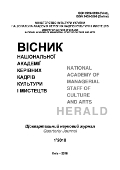INVESTIGATING THE EFFECT OF LEAD-RUBBER BEARINGS IN CONCRETE BUILDINGS FEATURING DUAL MOMENT FRAME AND SHEAR WALL SYSTEMS
DOI:
https://doi.org/10.32461/2226-3209.1.2018.177661Анотація
Abstract. One method of improvement and safeguarding the ductility is making use of seismic base isolation system. Seismic isolation system effectively isolates the building from the horizontal components of earthquake. The shear walls at the side of the moment frames can provide for a soft, resistant and ductile behavior of the whole building and toleration of the highest quotient of the base shear force that brings about a considerable increase in the building’s stiffness and a notable decrease in the damage to the nonstructural elements. The main objective of the present study
is the investigation of the seismic behavior of the isolated concrete buildings and comparison of the results with those obtained for fixed base structures. The study’s goal is actualized through nonlinear dynamic analyses using far and near-fault earthquake accelerographs assisted by ETABS V 9.6.0 and REFORM 3D software. The present study considers three seven-storey, twelve-storey and twenty-storey (representing short-, medium- and high-rise) structures featuring moment frame dual system with shear walls along the x- and y-axes and designs a lead-rubber base isolation system for them. On the other hand, the structure responses, including the floors’ relative displacements, floors’ shear
forces and the components’ internal forces have to also be made clear. The use of isolation systems in seven-storey and twelve-storey structures led to the reduction of responses and improvement of the structure behavior. As for the high-rise buildings with high alternating periods, the addition of isolation systems causes an increase in the structures’ responses.
Keywords: concrete buildings with shear walls, lead-rubber bearings, time history analysis, near- and far-fault earthquake
Посилання
Haqqollahi, A. and Ghiyami Ardebili, A., (2012), “seismic isolation of the structures using elastomeric
seismic isolation systems”, 1 st ed., Shahid Raja’ei Teacher Training University Press
M.Gokhale, P. Parametric Study of 1/24 Scale Laminated Rubber Bearing and Lead Core Rubber Bearing.University of Cincinnati. 2006
Providakis, C.P. Effect of LRB isolation systems and supplemental viscous dampers on seismic isolated
buildings under near-fault excitations. Engineering Structures 30, 1187–1198. 2008
Providakis, C.P. Effect of supplemental damping on LRB and FPS seismic isolation systems under near-fault
groundmotions. Soil Dynamics and Earthquake Engineering 29, 80–90. 2009
Shayanfar, M., and Torabi, S., (2011), “the effect of lead-rubber bearings on buildings with steel moment
frame system subject to far- and near-fault excitations”, Tehran, the second national conference on structures
and steel
Ja’afary, M., and Shakery, K., (2012), “the effect of lead-ruber isolation systems with different lateral
stiffness in concrete moment frame buildings”, the first national conference on the renovation and
strenghtening of the urban contexts adjacent to the active faults, Tabriz, Tabriz Municipality
SHARBATDAR, M.K., HOSEINI VAEZ, S.R., & GHODRATI AMIRI, G., & NADERPOUR, H. Seismic
Response of Base-Isolated Structures with LRB and FPS under near Fault Ground Motions. Procedia Engineering 14, 3245-3251. 2011
B.Salic, R., A. Garevski, M., & V.Milutinovic, Z. (2008). RESPONSE OF LEAD-RUBBER BEARING ISOLATED STRUCTURE. The 14 th World Conference on Earthquake Engineering, October 12-17, 2008,
Beijing, China
Shayanfar, M., and Torabi, S., (2011), “evaluation of the seismic behavior of the metal moment frame
buildings isolated using lead-rubber bearings based on dynamic time history analysis”, the third national
conference on urban reconstruction, Islamic Azad university, Sanandaj Branch
Shayanfar, M., and Torabi, S., (2011), “the effect of lead-rubber bearings on steel buildings with concentric
braced structures”, the sixth national conference on civil engineering, Semnan
Abdullahzadeh, Gh., and Ebrahimikhah, H., (2012), “the effect of the elastomeric base isolation systems on
the 3D model behaviors of steel structures with concentric braced structures”, Noushirvani Industrial University, Babol Branch
Heaton, TH., Hall, JF., & Wald, DJ., & Halling, MW. (1995). Response of high-rise and base-isolated
buildings to a hypothetical Mw 7.0 blind thrust earthquake. Science 267, 363–77
Kelly, JM. (1997). Earthquake-resistant design with rubber. 2nd ed. London: Springer
Makris, N., Chang, S. (1998). Effects of damping mechanisms on the response of seismically isolated structures. PEER report, Pacific Earthquake Engineering Research Center, College of Engineering,
University of California, Berkeley, CA
Saiful Islam, A.B.M., Rizwan Hussain, R., Zamin Jumaat, M., Ashiqur Rahman, M. (2013). Nonlinear dynamically automated excursions for rubber-steel bearing isolation in multi-storey construction. Automation in Construction, 30, 265-275
##submission.downloads##
Номер
Розділ
Ліцензія
Автори, які публікуються у цьому журналі, погоджуються з наступними умовами:
1. Автори залишають за собою право на авторство своєї роботи та передають журналу право першої публікації цієї роботи на умовах ліцензії Creative Commons Attribution License, котра дозволяє іншим особам вільно розповсюджувати опубліковану роботу з обов'язковим посиланням на авторів оригінальної роботи та першу публікацію роботи у цьому журналі.
2. Автори мають право укладати самостійні додаткові угоди щодо неексклюзивного розповсюдження роботи у тому вигляді, в якому вона була опублікована цим журналом (наприклад, розміщувати роботу в електронному сховищі установи або публікувати у складі монографії), за умови збереження посилання на першу публікацію роботи у цьому журналі.
3.Політика журналу дозволяє і заохочує розміщення авторами в мережі Інтернет (наприклад, у сховищах установ або на особистих веб-сайтах) рукопису роботи, як до подання цього рукопису до редакції, так і під час його редакційного опрацювання, оскільки це сприяє виникненню продуктивної наукової дискусії та позитивно позначається на оперативності та динаміці цитування опублікованої роботи.

